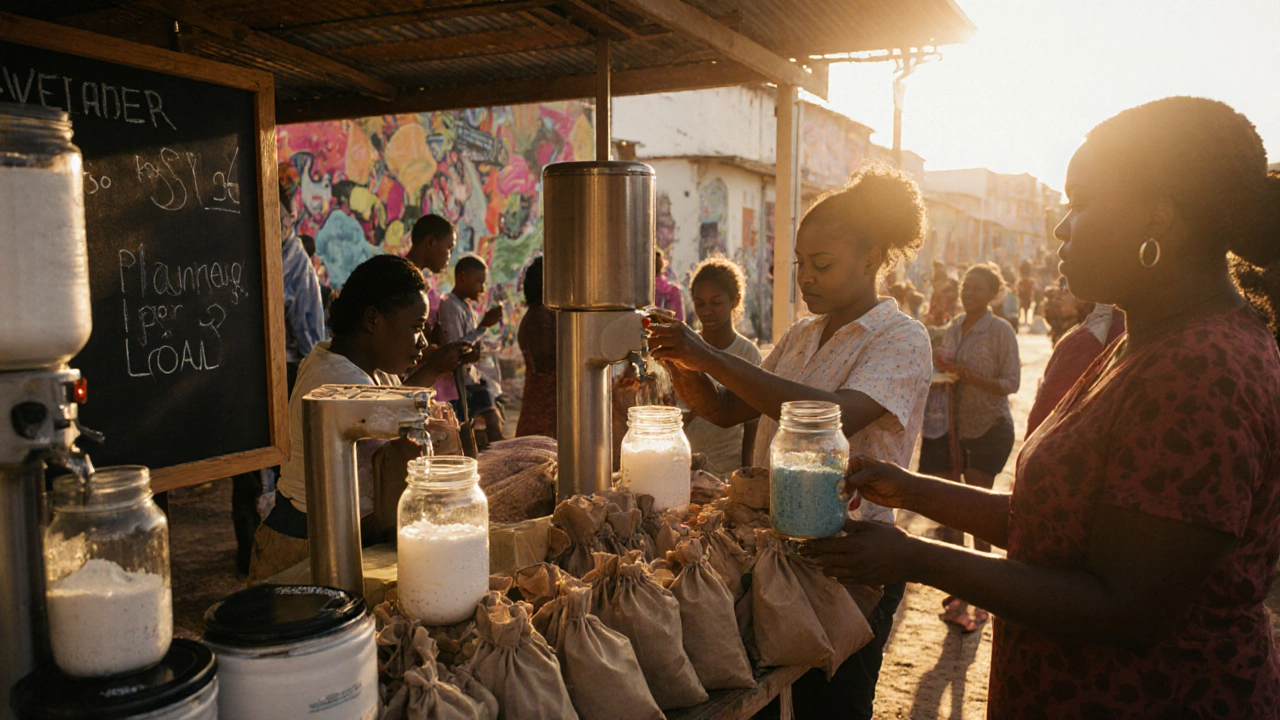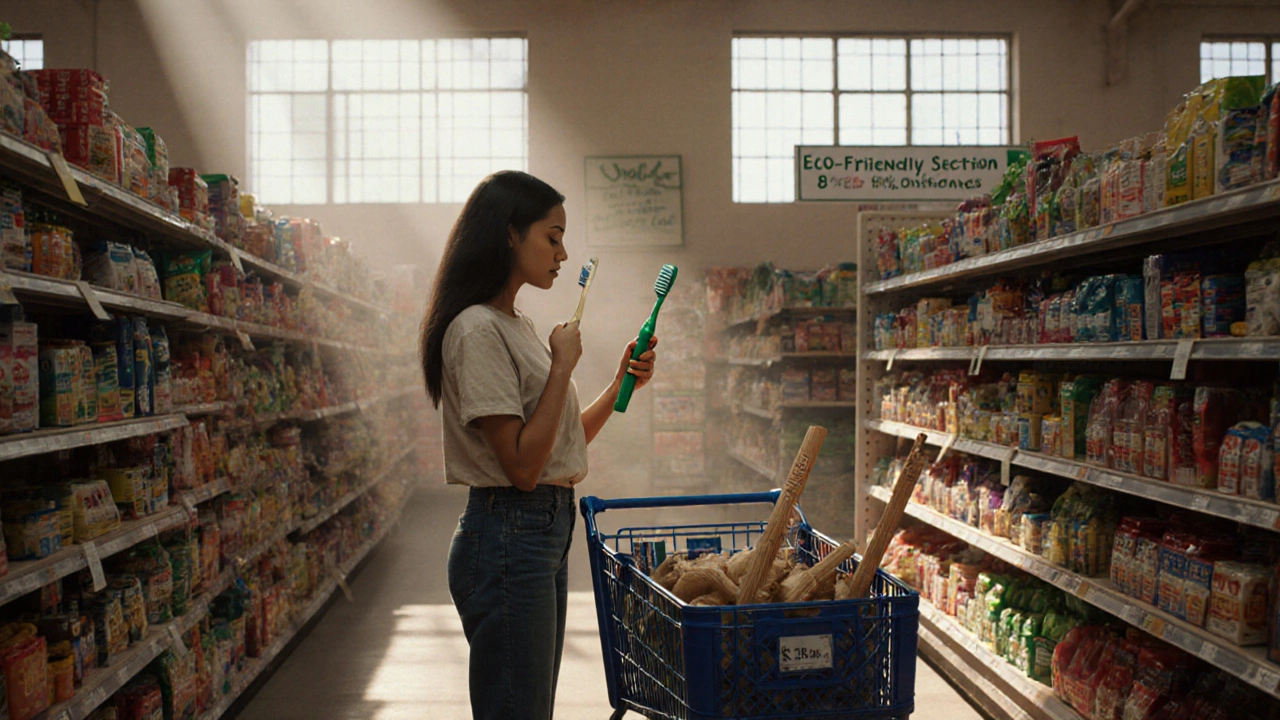Eco-Friendly Cost Calculator
Conventional Product
Eco-Friendly Alternative
It’s 2025, and you see eco-friendly products everywhere-reusable water bottles in every café, compostable packaging at the grocery store, bamboo toothbrushes on Amazon. Brands scream ‘green’ on their labels. Influencers post selfies holding plant-based soap. But here’s the real question: do people actually buy these products, or is it all just performative activism?
People Say They Care. Do They Spend Like It?
A 2024 NielsenIQ report showed that 73% of global consumers say they’d change their buying habits to reduce environmental impact. Sounds promising, right? But when you look at actual sales data, the numbers drop. In South Africa, for example, sales of certified eco-friendly household cleaners grew by just 8% last year-while regular chemical cleaners still made up 89% of total sales. Same story in the U.S. and Europe. People talk about sustainability. They share infographics. But when they’re standing in front of a $4 bamboo toothbrush versus a $1 plastic one, the cheaper option wins more often than not.Why? Because eco-friendly doesn’t always mean affordable. A reusable grocery bag might cost $5. A pack of 100 plastic bags costs $0.99. A refillable deodorant tube is $18. A conventional one is $4. For families on tight budgets, especially in places like Durban or Cape Town where inflation hit 5.8% in 2024, price isn’t just a factor-it’s a dealbreaker.
It’s Not Just About Price
Let’s be honest: convenience kills good intentions. If you’re rushing to get the kids to school, grabbing the first thing on the shelf matters more than whether it’s biodegradable. Most people don’t have time to research certifications, read ingredient lists, or hunt down zero-waste stores. A 2023 study by the University of Cape Town found that 62% of shoppers who wanted to buy eco-friendly products gave up because they couldn’t find them nearby.And let’s not forget greenwashing. Brands slap ‘eco’ or ‘natural’ on products that are still made with synthetic chemicals, shipped across oceans, and wrapped in plastic. A 2024 investigation by the South African National Consumer Commission found that 41% of products labeled ‘eco-friendly’ had no third-party certification. That erodes trust. If you’ve been fooled once, why risk it again?
Who’s Actually Buying These Products?
It’s not everyone. But it’s not no one either. The real buyers fall into three groups:- Young urban professionals (25-40 years old) in cities like Johannesburg, Cape Town, and Durban. They have disposable income, use social media, and care about brand ethics. They’re the ones buying refillable shampoo bars and solar-powered phone chargers.
- Parents concerned about toxins. These shoppers don’t buy eco-friendly because it’s trendy-they buy it because they’re scared of what’s in their child’s laundry detergent or baby wipes. A 2025 survey by the South African Pediatric Association showed 57% of parents switched to fragrance-free, plant-based products after learning about endocrine disruptors.
- Older adults with long-term health issues. People with allergies, asthma, or chemical sensitivities have been choosing natural products for decades. They don’t need a trend to justify it. For them, it’s medical necessity.
These groups make up about 28% of the population. Not a majority. But enough to keep the market alive-and growing slowly.

The Real Drivers of Change
Here’s the thing: people don’t buy eco-friendly products because they’re told to. They buy them when it becomes easier, cheaper, or unavoidable.Take plastic bags. In 2022, South Africa introduced a new levy on single-use plastic bags. The price went from free to 25 cents per bag. Sales of reusable bags jumped 217% in six months. Not because people suddenly became environmental warriors. Because it cost more to ignore the change.
Same with electric vehicles. Tesla didn’t win because people loved the brand. They won because charging stations became widespread, tax rebates kicked in, and fuel prices hit R28 per liter. When the system changes, behavior follows.
That’s the key insight: eco-friendly products don’t need more marketing-they need better infrastructure. More refill stations. More bulk stores. More local manufacturing. Fewer imports. If you want people to buy sustainable, make it the default option.
What’s Working Right Now
Some brands are getting it right. Take Earthwise, a Durban-based company that sells laundry detergent in compostable paper pouches you refill at local drop points. No plastic. No shipping emissions. Cost per load: 30 cents. They’ve grown 140% year-over-year because they solved the two biggest problems: price and access.Another example: GreenGrocer, a small chain in Cape Town, lets customers bring their own containers. No packaging fee. No minimum spend. They’ve built a loyal customer base not by preaching sustainability, but by removing friction.
These aren’t niche experiments. They’re scalable models. And they’re growing because they’re practical-not preachy.

Will This Keep Growing?
Yes-but not because of guilt trips or Instagram posts. It’s growing because climate change is no longer a distant threat. In 2024, Durban had its worst flooding in 20 years. Cape Town’s water restrictions returned after a three-year break. People are seeing the cost of inaction in their daily lives.Younger generations aren’t waiting for governments to fix it. They’re changing how they shop. A 2025 study by Stellenbosch University found that 78% of Gen Z respondents said they’d rather work for or buy from a company that takes real environmental action-not just one with a green logo.
That’s the real shift. It’s not about being eco-friendly for virtue signaling. It’s about survival. About responsibility. About not handing a broken world to your kids.
So, Do People Buy Eco-Friendly Products?
The answer isn’t yes or no. It’s: not enough yet-but more than you think, and it’s getting better.Most people still choose convenience and cost. But a growing segment is making different choices-and they’re influencing the market. Retailers are noticing. Suppliers are shifting. Governments are being pressured. Slowly, the system is changing.
Don’t look at the big picture and feel discouraged. Look at the person next to you in the grocery line, handing over their own jar to fill with oats. That’s the real movement. Not the hashtags. Not the ads. The quiet, consistent, everyday decisions.
People don’t need to be perfect. They just need to start. And more of them are.
Are eco-friendly products really better for the environment?
It depends. A product labeled ‘eco-friendly’ isn’t automatically good. A bamboo toothbrush made in China, shipped overseas, and wrapped in plastic might have a bigger carbon footprint than a plastic one made locally. Look for certifications like Fair Trade, Cradle to Cradle, or SABS Green Label. Local, refillable, and reusable options usually win. The best eco-product is the one you already own-use it longer.
Why are eco-friendly products so expensive?
They’re not inherently expensive-they’re just made differently. Conventional products use cheap, mass-produced materials and hidden environmental costs (pollution, waste, health impacts) that aren’t priced in. Eco-friendly products pay for ethical labor, sustainable sourcing, and non-toxic ingredients. But prices are dropping as demand grows and local production increases. In South Africa, refill stations and bulk stores are cutting costs by 30-50% compared to packaged brands.
Can one person really make a difference?
Yes. One person switching to a reusable water bottle saves about 150 plastic bottles a year. Multiply that by 10,000 people in a neighborhood, and you’re preventing 1.5 million bottles from entering landfills or oceans. It’s not about being perfect. It’s about scaling small actions. The biggest change comes from collective habits, not heroic gestures.
What’s the easiest eco-friendly swap I can make today?
Start with laundry. Switch to a concentrated, biodegradable detergent in a refillable bottle. It cuts plastic waste, reduces chemical runoff, and costs less per wash. You can find these at local co-ops or online stores like Earthwise or GreenGrocer. Bonus: your clothes smell better without artificial fragrances.
Do eco-friendly products last longer?
Often, yes. Reusable silicone bags outlast plastic zip-lock bags. Stainless steel straws last decades. Glass jars can be washed and reused hundreds of times. Cheap plastic breaks. Eco-friendly alternatives are built to be durable, not disposable. That’s why they’re better for your wallet over time-even if the upfront cost is higher.
Next time you’re at the store, ask yourself: What’s the easiest change I can make this week? Maybe it’s bringing a bag. Maybe it’s choosing a bar of soap over a bottle. It doesn’t have to be huge. Just real. That’s how change starts.
